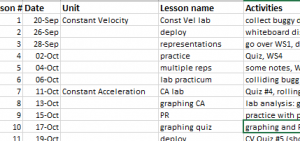Help with my physics schedule please!
One thing that I’ve struggled with for years is trying to fit in the curricular content for physics 11. I know that I’m weeks behind most physics teachers in BC. I always start the year off with the best intentions with planning, and the planning is generally ok in that I remain focused on the goals and sequence.*
I’m interested in trying to improve my sequence and scheduling so that it is appropriate in coverage and understanding, and accomplishes what I want it to, recognizing that unit planning is a personal thing even when working within the guidelines of the set curriculum. Below I have a link to my current year’s schedule to-date and I hope that you can look at it and leave some constructive comments. Before I get to that though I would like to reflect a bit on what we’ve been doing this year.
I have been maintaining my interest in following the Modeling Instruction curriculum as best as I can. This in itself is difficult for three reasons. First, I do not have probeware and the original papers that outline modeling instruction explicitly say that probeware is needed. My lack of probeware restricts the number of experiments we can effectively carry out in terms of speed and clarity. My second problem is that I suspect the modeling instruction sequence at least partially depends on some daily homework. I ask that students do homework when they need to finish something that they did not during a reasonable amount of classtime, but it’s rare for me to ask the students to spend 20 minutes on an activity/worksheet and then tell them to finish the rest at home. If I did use the “20min and the rest done at home” scheme, I think that only 1/3 of the students would complete and understand the work. The third issue I have with modeling is that I have seen only a limited amount of whiteboard sessions from experienced and expert modelers. I’ve been avoiding a lot of whiteboard work because it seems to be even slower and adds to my stress for pacing. I can assign a worksheet to the class and have them work through it, but if I give out a worksheet and then have them whiteboard a problem, it would take maybe 45 min for the class just to get through 4 or 6 problems.
The result of the 3 issues above is that I don’t know if my students are benefiting from the time we spend on setting up models and scaffolding the activities. For example, in the Energy unit I’m using a sequence that goes like this: definition of energy, pie charts and energy transfers in closed isolated systems, bar charts tracking energy transfers, calculating energies, using bar charts to quantitatively analyze energy problems, and finally a typical BC physics 11 worksheet on conservation of energy. I’m not really convinced that my students are any better at the typical BC physics 11 worksheet than a student that skips the pie charts and bar graphs.** That’s probably on me because I don’t do a good enough job of reinforcing the beginning ideas with the final comprehensive learning outcome. I think students see the final worksheets/problems as a new entity and don’t explicitly try to use their prior knowledge on energy transfers. The same thing happens with unbalanced forces. When my students get to the end of the unit and are doing complex Newton’s Second Law questions, they don’t use force diagrams. If I gave the N2 worksheet as an activity for drawing force diagrams, they’d probably perform fairly well. When there are a bunch of numbers wrapped around the scenario though, the prior knowledge is thrown out the window. Perhaps this is due to cognitive load, but at some point the students have to get to this level of complexity.
If anyone is (hopefully) interested, I’ve put together a spreadsheet that shows my lesson progression this year. It’s not super detailed but I think it should give a person a pretty good idea of what my students have been doing and how much time they’ve been spending on different activities. If you can scan through this document and leave some feedback, I would be very grateful. There are a few places where it might look like I’m skipping around the curriculum a bit. Most of this is intentional with interleaved and distributed practice. I did mess up a bit with the proportional reasoning and graphing assessment though (Day 9).
* This year is a bit of anomaly with one of my classes. The culture of the classroom is a bit confrontational and most of the students don’t have any intention of studying physics past this course. There have been lots of absences, people joining the class late, etc. I try to sympathize with the students and their position, and validate their concerns. Still, it slows the whole process down.
** After seeing how much students need to really think and struggle with bar graphs in Conservation of Energy questions, I personally have little faith that the average physics 11 student in BC has a good understanding of what they’re doing with this type of problem/analysis. If you can’t sketch a few bar graphs, I’m not sure how plugging numbers into an equation is going to elicit any further understanding. Perhaps I’m wrong on this.

